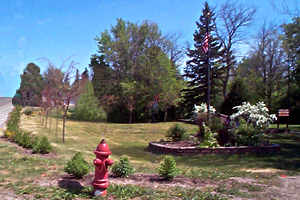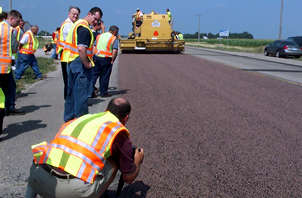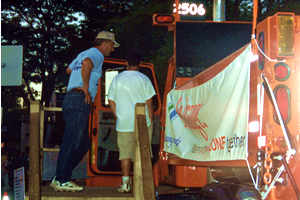 |
 |





 |
 |
 |
 |
 |
 |
Cook Airport first to join Adopt-An-Airport program
|
 |
 |
 |
Displaying the names of Cook Airport's new adoptive groups are, from
left: Dr. Steve Towle, Cook Airport commissioner, Commissioner Elwyn Tinklenberg,
and Tom Woock, Cook municipal airport director. Cook Airport is the first
to join Mn/DOT’s new Adopt-An-Airport program. Photo by Janese Thatcher-Buzzell
|
Commissioner Elwyn Tinklenberg lauded the Cook Airport Commission and staff
during the annual Cook Fly-in on July 20 for becoming the first Minnesota airport
to participate in the new Adopt-An-Airport program developed by the Office of
Aeronautics.
"Our new Adopt-An-Airport program makes citizens more aware and supportive
of their local airport and gives them some ownership. It also gives folks the
chance to learn more about aviation and what happens at airports," said
Tinklenberg during the ceremony to honor Cook Airport.
"And, of course, as groups sign up to support the program, they benefit
by having their names out in front of the community as strong community supporters,"
he added.
He thanked the airport as well as the six community groups that have pledged
their support so far: Friends of Aviation, Ludlow’s Island Resort, BIC Realty,
the Cook News-Herald; Zups Market of Cook and Vermilion Construction.
"When I attended the Minnesota Council of Airports symposium in April
and heard about the new program, I knew it would be a good program for the Cook
municipal airport," said Dr. Steve Towle, Cook Airport commissioner. "As
it turned out, so did many community members because they called to ‘adopt’
the airport as soon as they heard about the airport participating in the program."
Adopt-An-Airport is a volunteer program open to civic clubs, chambers of commerce,
business and professional organizations, community groups and individuals. The
groups work with airport management to decide how to best help support, maintain
or beautify the airport.
"The program offers volunteers the opportunity to contribute to their
community," said Janese Thatcher-Buzzell, Mn/DOT’s program coordinator.
"We’re excited that Cook is the first to sign on and we look forward to
working with them in this program."
Since the program began in April, two more Minnesota airports have agreed to
participate, Alexandria and Duluth.
For background on the new program, please see previous article in the May
8 Newsline e-bidding update.
By Lucy Kender
|
back

|
 |
New electronic bidding process saves time, money
|
 |
 |
July marks Mn/DOT’s first six months of using the electronic submittal process
for bidding on construction projects.
Mn/DOT moved to electronic bidding in January 2002 to increase the efficiency
of the contractor’s bidding practices and help ensure safe, timely delivery
by eliminating travel time.
Mn/DOT will save approximately $60,000 annually with the reduction of data
entry fees and staff hours. In the past, Mn/DOT audited each bid that was submitted,
which required approximately 150 staff hours annually to rectify due to state
and federal requirements regarding acceptance of incomplete bids or those containing
errors.
"Mn/DOT has had to reject lowest bidders because of bid errors on numerous
occasions, and in some instances, the cost to go to the next bidder is a considerable
sum," said Gary Ericksen, Office of Construction and Contract Administration.
The new electronic bidding software has safeguards that notify contractors
about data entry errors and incomplete forms. This feature alone will greatly
diminish the need to go to a second bidder, he said.
Approximately 50 percent of construction contractors use the new electronic
bidding process. The process calculates all the figures for the contractors
and allows them to submit bids just minutes before the submittal deadline. With
no necessary travel time involved, contractors can stay in their offices and
obtain quotes from sub-contractors and suppliers.
"I talked to one contractor and he said that by not being on the road
to deliver the bid to us, he was in his office and received a call from a steel
supplier who dropped his quote by $50,000," said Ericksen. "The contractor
submitted the new quote in the electronic bidding system, and because of the
price reduction, the contractor was awarded the job. There alone, Mn/DOT saved
$50,000."
Mn/DOT continues to accept hard copy bids to accommodate disadvantaged business
enterprises and those who have not adopted the new system.
"This is a great system for everyone. The convenience of submitting bids
electronically will increase the number of bids received. More bids equals lower
prices," he said.
By Daneeka Marshall-Oquendo
|
back

|
 |
Duluth crew builds natural fence to protect veterans’ memorial
|
 |
 |
 |
Shrubbery planted by
Mn/DOT crews to protect this Floodwood Park veterans' memorial struggles
to grow back in spite of damage from tent caterpillars. Photo by Tom
Jacobson
|
Concerned that operators of three-wheelers, four-wheelers and other vehicles
were damaging the veterans’ memorial in Floodwood Park, caretaker Bob Palmer
put up a bright orange plastic fence for protection in the right of way along
Hwy 73.
Palmer’s fence didn’t pass muster with Duluth/District 1, but his desire to
protect the v-shaped stone memorial, trees and other landscaping materials earned
notice. Twelve trees were planted to honor 12 Floodwood residents who died fighting
in the nation’s wars.
After removing the fence, district maintenance staff decided that a fence made
of shrubs and bushes would help protect the memorial and blend with the park’s
landscape setting as well.
After consulting with Palmer, Tom Jacobson, landscape specialist at Duluth,
designed a row of plantings 130 feet long and three feet wide along the highway.
Working with Monica Hendrickson, maintenance supervisor at Floodwood; Gary
Karkianen, Floodwood, and Ken Lindstrom, Duluth, Jacobson planted lilacs, honeysuckle
and other native plants adjacent to the park.
Jacobson said tent caterpillars damaged the new plants this year, but he expects
the shrubs to recover and to provide an effective but attractive buffer area
to protect the memorial and the park.
|
back

|
 |
New ‘macro-surfacing’ chip sealing process promises long-term pavement protection
|
 |
 |
 |
Representatives from
Mn/DOT, other agencies and the contracting firm observe a freshly laid
‘macro-surfacing’ overlay on Hwy 14 near Waseca. The process promises
to extend pavement life longer than standard resurfacing practices. Photo
by Rebecca Arndt
|
Macro-surfacing—a new chip seal technique—promises to reduce the time needed
to complete asphalt overlays and extend the life of the highway for twice as
long as conventional sealing methods.
Mankato/District 7 recently used the new method on an eight-mile section of
Hwy 14 between Janesville and Waseca to determine its effectiveness.
The new sealing method includes placing an extra layer of sealant to keep aggregate
rock from damaging vehicles and applying a new asphalt compound and quartzite
at the same time. Applying the asphalt and rock at the same time speeds the
process and allows paving crews to cover more territory in less time, said Steve
Oakey, Mankato/District 7 materials engineer.
Oakey said their use of the process is the first time it has been used in the
United States with a competitive bid.
The process differs from the standard chip seal method by using one paving
machine to apply the sealant oil and the aggregate simultaneously.
One application and the quick-drying sealant developed by the Koch Refining
Co. near Hastings enables the application to cure in about one hour instead
of four to five hours for the standard process, Oakey said.
"Because the ‘stickier’ modified oil can hold the rock in place, we anticipate
successful use of the process on high-speed, high-volume roadways," he
said.
Oakey said standard seal coats will keep moisture from damaging pavement for
three to five years but the new process will protect the pavement for as long
as seven years.
The new process is more costly, he said, but should be more economical in the
long run.
The district will monitor the project for skid resistance, noise levels, ride
smoothness and other factors, Oakey said.
"This process is part of looking at alternatives to extend road life as
we research additional preventive maintenance measures," he said.
By Craig Wilkins
|
back

|
 |
Staff draws inspiration from pop culture when naming ponds
|
 |
 |
There’s Bart, Marge, Milhouse, Cletus, and of course, Homer. Nearby are Milhouse,
Lenny, Itchy, Wiggum and Apu, the Quik-E-Mart clerk. Characters on The Simpsons?
D’oh! They’re also names for Mn/DOT’s drainage ponds at I-494 and Hwy 61 for
the Wakota Bridge project in Newport.
In the Land of 10,000 Lakes, there are a whole lot of highway drainage ponds
as well. Naming them with letters or numbers led to confusion, so Metro Division
hydrologists came up with character names from The Simpsons, the Three
Stooges, Happy Days, Star Wars and other pop culture sources
to identify each pond individually.
You won’t see signs designating them as Curly, Chachi or Kenobi, but the names
make things a lot easier for hydrologist Patrick McLarnon and his colleagues
to keep hundreds of ponds at various interchanges straight.
The distinctive names, he adds, helps them determine the ponds’ location, the
project they’re a part of and their function. He said, for example, that "wet"
ponds that settle out sediments heavy metals, phosphorus and other pollutants
to keep them from entering bodies of water and "dry" ponds that provide
storage capacity when runoff levels are high.
"We used to name them 1-2-3 or A-B-C but that was pretty confusing because
we could have 20 Pond A’s," he said. "Using the character names makes
them much easier to remember."
Besides that, he said, it’s fun.
McLarnon said he doesn’t know what the source will be for the next round of
pond designations, but whatever it is, it will have a lot of characters.
By Craig Wilkins
|
Days of Our Lives
films Transportation Building for background setting
And speaking of popular culture, a video crew from the TV soap opera
Days of Our Lives filmed several locations in St. Paul including
Rice Park, downtown buildings, the city’s skyline and the Transportation
Building for new exterior scenes.
Set in the fictional city of Salem in "Middle America," the
program’s producers needed fresh footage to establish places where the
show’s characters live, work and whatever else soap opera characters
typically do.
No cast members are in the scenes shot in St. Paul.
The program, which has been broadcast since 1965, airs at noon weekdays
on KARE-TV, Channel 11.
|
|
back

|
 |
Managers urged to submit 2003 legislative proposals by Aug. 9
|
 |
 |
Mn/DOT’s managers are urged to submit proposals by Aug. 9 for the 2003 Legislature
to consider in order to prepare for the next legislative session.
Betsy Parker, associate director, Government Relations, said the governor has
directed state agencies to proceed in the usual manner even though there will
be a new administration in January 2003.
Employees who have proposals to be addressed by the Legislature need to forward
them to their managers before Aug. 9.
The commissioner’s executive team will review the proposals. Forms for submitting
proposals are available from Diane Leuzinger, 651/297-2932.
Parker said the proposals should include fiscal data as well as information
about potential supporters and opponents. All proposals must be approved by
the appropriate group director before submittal.
|
back

|
 |
Volunteers needed to work at State Fair
|
 |
 |
 |
A Mn/DOT worker explains
the operation of a snowplow truck to visitors at the department’s exhibit
at the Minnesota State Fair. Photo by Kevin Walker
|
Mn/DOT needs employees to share their knowledge about transportation and the
department’s operations to work at Mn/DOT’s booth during the 2002 Minnesota
State Fair in St. Paul.
The exhibit’s theme is "The Mn/DOT Zone" and will showcase district
and Metro Division projects and operations, new technology, multi-modal offices
and career opportunities.
At the fair, which begins Aug. 22 and ends Sept. 2, the department will also
conduct an informal poll of exhibit visitors to measure their interest, priorities
and concerns about transportation issues.
"Mn/DOT’s fair exhibit is designed to inform the people of Minnesota about
the world of transportation and that’s where volunteers fit in," said Mary
Meinert, Communications and Public Relations. "Our exhibit needs their
knowledge and work experience with the department."
Each district office will be responsible for staffing the exhibit for one day.
Metro Division and Central Office employees will work on weekends and Labor
Day. Volunteers will work four-hour shifts and receive an admission ticket and
a T-shirt to wear when they are working.
District employees may contact their public affairs coordinator to volunteer.
Metro and Central Office employees may contact Kathy Lehner at 651/297-4253
to volunteer. Employees need supervisory approval before volunteering to work
at the fair.
|
back

|
|



